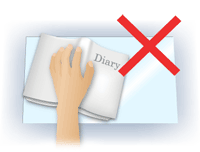IJ Scan Utility (macOS) - Image Corrections and Color Adjustments with the Scanner Driver
| Article ID: ART176185 |
| |
Date published: 01/17/2020 |
| |
Date last updated: 01/21/2020 |
Description
This article contains information on image corrections and color adjustments when scanning with the scanner driver through IJ Scan Utility on macOS.
Solution
Image Corrections and Color Adjustments
You can correct images and adjust colors using the scanner driver.
 Important
Important
-
When image correction or color adjustment is applied to items without moire, dust/scratches, or faded colors, the color tone may be adversely affected.
-
Image correction results are not reflected in the trial scan screen.
 Note
Note
-
Screens may vary depending on the application.
-
Selectable settings depend on Kind settings.
-
Scanning may take longer than usual when image correction or color adjustment is applied.
-
Image Adjustment
-
When Image Adjustment is set, the brightness of the specified portion of the image is optimized. Images can be adjusted according to the automatically detected item type or the specified item type. The result of the adjustment will be reflected in the entire image.
-
None
-
Image Adjustment will not be applied.
-
Auto
-
Applies Image Adjustment by automatically detecting the item type. It is recommended that you normally select this setting.
-
Photo
-
Applies Image Adjustment suitable for photos.
-
Magazine
-
Applies Image Adjustment suitable for magazines.
-
Document
-
Applies Image Adjustment suitable for text documents.
 Note
Note
-
If the image is not adjusted properly with Auto, specify the item type.
-
The color tone may change from the source image due to the Image Adjustment. In that case, set Image Adjustment to None.
-
Reduce Dust
-
Scanned photos may contain white dots caused by dust or scratches. Use this function to reduce such noise.
-
None
-
Dust and scratches will not be reduced.
-
Low
-
Select this to reduce small dust particles and scratches. Large ones may remain.
-
Medium
-
It is recommended that you normally select this setting.
-
High
-
Select this to reduce large dust particles and scratches; however, evidence of the reduction process may remain or delicate parts of the image may be removed.
 Important
Important
 Note
Note
-
Fading Correction
-
Use this function to correct photos that have faded with time or have a colorcast. "Colorcast" is a phenomenon where a specific color affects the entire picture due to the weather or ambient strong colors.
-
None
-
Fading Correction will not be applied.
-
Low
-
Select this to correct a small amount of fading and colorcast.
-
Medium
-
It is recommended that you normally select this setting.
-
High
-
Select this to correct a large amount of fading and colorcast. This can affect the tone of the image.
 Important
Important
-
Grain Correction
-
Use this function to reduce graininess (roughness) in photos taken with high-speed or sensitized film, etc.
-
None
-
Graininess will not be reduced.
-
Low
-
Select this when the photo is slightly grainy.
-
Medium
-
It is recommended that you normally select this setting.
-
High
-
Select this when the photo is very grainy. This can affect the gradation and sharpness of the image.
 Important
Important
-
Gutter Correction
-
Use this function to correct shadows that appear between pages when scanning open booklets.
Unclear or blurred text/lines caused by curved pages are not corrected.
-
None
-
Gutter shadow will not be corrected.
-
Low
-
Select this when the effect level is too strong with the medium setting.
-
Medium
-
It is recommended that you normally select this setting.
-
High
-
Select this when the effect level is too weak with the medium setting.
 Important
Important
-
Do not place objects that weigh 4.4 lbs (2.0 kg) or more on the platen. In addition, do not press on the item with a force exceeding 4.4 lbs (2.0 kg). If you press heavily, the scanner may not work correctly or you might break the glass.
-
Align the item with the edge of the platen. If placed slanted, correction will not be applied properly.

-
Correction may not be applied properly depending on the item. If the page background is not white, shadows may not be detected correctly or may not be detected at all.
-
While scanning, press down on the spine with the same amount of pressure you used to preview the scan. If the binding part is not even, correction will not be applied properly.


-
How to place the item depends on your model and the item to be scanned.
-
Unsharp Mask
-
Emphasizes the outline of the subjects to sharpen the image.
-
Descreen
-
Reduces moire patterns.
Printed materials are displayed as a collection of fine dots. "Moire" is a phenomenon where uneven gradation or a stripe pattern appears when such photos or pictures printed with fine dots are scanned.
 Important
Important
 Note
Note
-
Reduce Show-through
-
Use this function to reduce show-through in duplex documents or lighten the base color in recycled paper and other colored paper when scanning documents.
 Important
Important
-
Calibrate before each scan
-
Calibrates the scanner every time before trial scanning and scanning, to reproduce correct color tones in scanned images.
 Note
Note